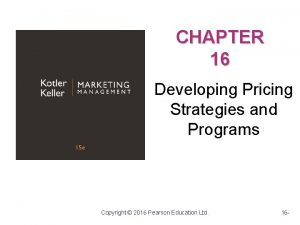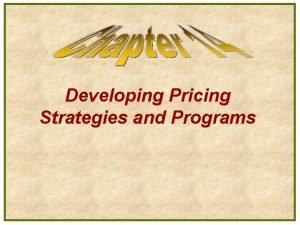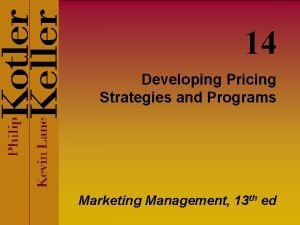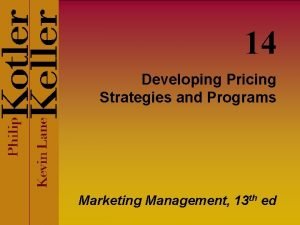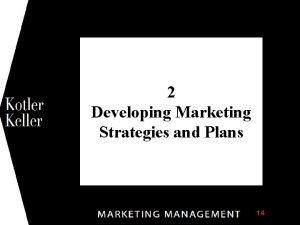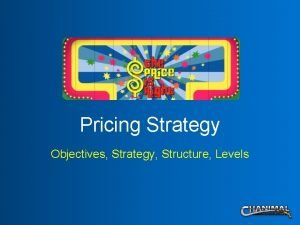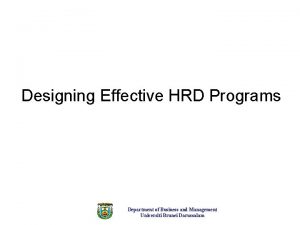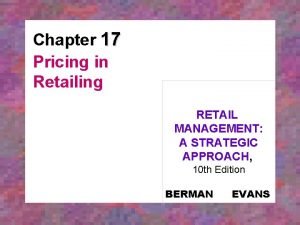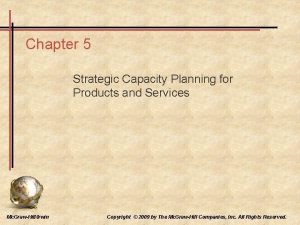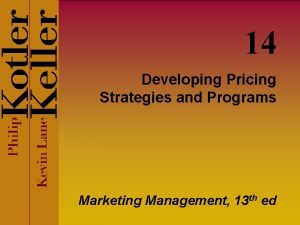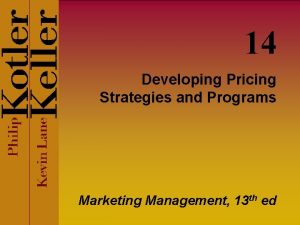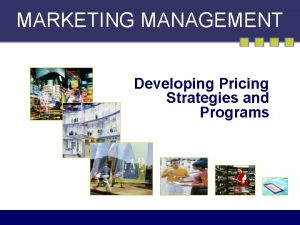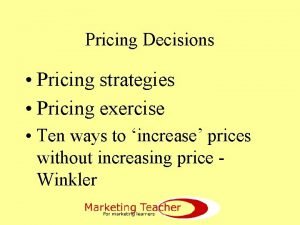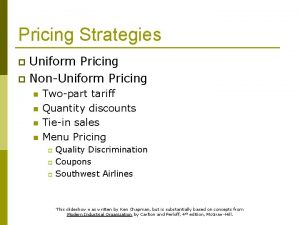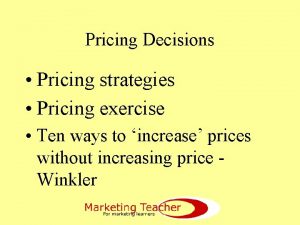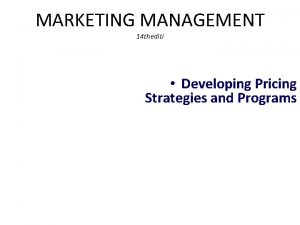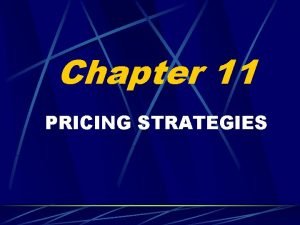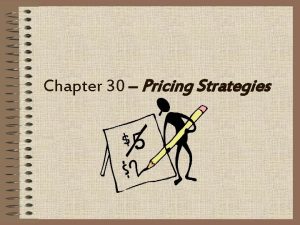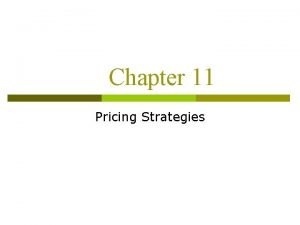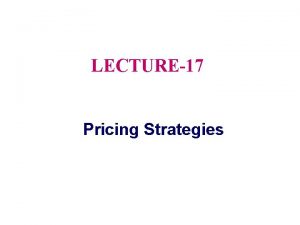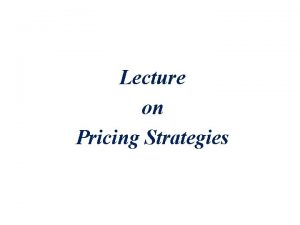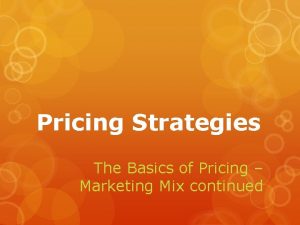MARKETING MANAGEMENT Developing Pricing Strategies and Programs What




















- Slides: 20

MARKETING MANAGEMENT Developing Pricing Strategies and Programs

What is Price? Price: is the sum of all values that consumers exchange for the benefits of having or using the product or service. 14 -2

Price has many names: • • • Rent Tuition Fare Rate Commission Wage • • • Fee Dues Interest Donation Salary 14 -3

Steps in Setting Pricing 14 -4

Setting the Pricing Steps 1. 2. 3. 4. 5. 6. Select pricing objective Determine demand Estimate costs Analyze competition Select pricing method Select final price • Survival • Maximize current profits • Maximize market share – Penetration strategy • Market skimming – Skimming strategy • Product quality leaders • Partial cost recovery 14 -5

Setting the Pricing Steps 1. 2. 3. 4. 5. 6. Select pricing objective Determine demand Estimate costs Analyze competition Select pricing method Select final price • Understand factors that affect price sensitivity • Estimate demand curves ü Statistical analysis ü Price experiments ü Surveys • Understand price elasticity of demand ü Elasticity ü Inelasticity 14 -6

Consumers are less price sensitive when: • Product is more distinctive • Buyers are less aware of substitutes • Buyers cannot easily compare quality of substitutes • The expenditure is a lower part of buyer’s total income • The expenditure is small compared to the total cost • Part of the cost is borne by another party • The product is used with assets previously bought • The product is assumed to have more quality, prestige, or exclusiveness • Buyers cannot store the product Internet increases customers’ price sensitivity 14 -7

Inelastic & Elastic Demand 14 -8

Demand is less elastic under these conditions: • There are few or no substitutes/competitors • Buyers do not readily notice the higher price • Buyers are slow to change their buying habits and search for lower prices • Buyers think higher prices are justified 14 -9

Setting the Pricing Steps 1. 2. 3. 4. 5. 6. Select pricing objective Determine demand Estimate costs Analyze competition Select pricing method Select final price • Types of costs and levels of production must be considered • Accumulated production leads to cost reduction via the experience curve • Differentiated marketing offers create different cost levels (Activitybased cost ABC) 14 -10

Setting the Price Key Pricing Terms: § Fixed costs/overhead: costs that don’t vary with production or sales revenue. § Variable costs: vary with the level of production. § Total costs: sum of fixed and variable costs at a given level of production § Average cost: cost per unit at a given level of production = total cost/quantity of production. 14 -11

Cost per Unit as a Function of Accumulated Production: The Experience Curve 14 -12

Setting the Pricing Steps 1. 2. 3. 4. 5. 6. Select pricing objective Determine demand Estimate costs Analyze competition Select pricing method Select final price • Firms must analyze the competition with respect to: ü Costs ü Prices ü Possible price reactions • Pricing decisions are also influenced by quality of offering relative to competition 14 -13

Setting the Pricing Procedure 1. 2. 3. 4. 5. 6. Select pricing objective Determine demand Estimate costs Analyze competition Select pricing method Select final price • Price-setting begins with the three “Cs” • Select pricing method: – – – Markup pricing Target-return pricing Perceived-value pricing Value pricing Going-rate pricing Auction-type pricing 14 -14

Pricing Methods: 1. Markup pricing Standard markup add to the product cost 2. Target-Return Pricing pricing used to achieve a planned or target rate of return on investment 14 -15

Pricing Methods: 3. Perceived-Value Pricing • Companies base their price on the customer’s perceived value. • The key to perceived-value pricing is to deliver more value than the competitor and to demonstrate this to prospective buyers. • There are three groups of buyers : ü Price buyers ü Value buyers ü Loyal buyers 14 -16

Pricing Methods: 4. Value Pricing • Win loyal customer by charging a fairly low price for a high-quality offering, that means : reengineering the companies operations to be low -cost without sacrificing quality. 5. Going-Rate Pricing • The firm bases its price largely on competitors’ prices. (smaller firms “follow the leader”). • It is quite popular where costs are difficult to measure or competitive response is uncertain. 14 -17

Pricing Methods: 6. Auction-Type Pricing • • One major purpose of auctions is to dispose of excess inventories or used goods. Three major types of auctions: 1 - English auctions (ascending bids). 2 - Dutch auctions (descending bids). 3 - Sealed-bid auctions. 14 -18

Setting the Pricing Steps 1. 2. 3. 4. 5. 6. Select pricing objective Determine demand Estimate costs Analyze competition Select pricing method Select final price • Requires consideration of additional factors: – Impact of other marketing mix variables – Company pricing policies – Gain-and-risk-sharing pricing – Impact of price on other parties 14 -19

• https: //drive. google. com/open? id=1 LRKo. M LK 3 rp. SH 6 Hy 6 m. R 8 x. Fx 4 Hl 6 pg. Tk. N 6 14 -20
 Target rate of return pricing
Target rate of return pricing Segmented pricing
Segmented pricing Developing pricing strategies and programs
Developing pricing strategies and programs Developing pricing strategies and programs
Developing pricing strategies and programs The marketing plan the central instrument
The marketing plan the central instrument Developing marketing strategies and plans
Developing marketing strategies and plans Chapter 2 developing marketing strategies and plans
Chapter 2 developing marketing strategies and plans Pricing tripod in service marketing
Pricing tripod in service marketing Pricing strategies in marketing
Pricing strategies in marketing Developing and pricing goods and services
Developing and pricing goods and services Designing and developing effective hrd programs
Designing and developing effective hrd programs Hrd program
Hrd program Pricing in retailing
Pricing in retailing Price adjustment in retail management
Price adjustment in retail management Overview of software engineering
Overview of software engineering Pricing and distribution strategies
Pricing and distribution strategies Global pricing objectives and strategies
Global pricing objectives and strategies Facile stage of numeracy
Facile stage of numeracy Developing efficient numeracy strategies
Developing efficient numeracy strategies Strategic capacity planning for products and services
Strategic capacity planning for products and services The wheel of loyalty
The wheel of loyalty
